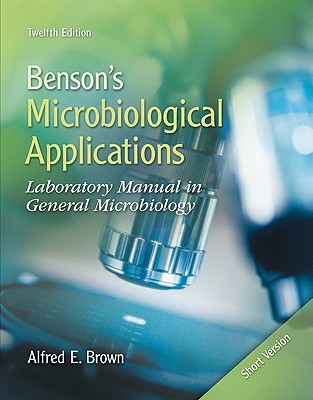📘 قراءة كتاب Microbiological Applications Lab Manual أونلاين


دليل معمل التطبيقات الميكروبيولوجية من كتب علمية
بنسون:
دليل معمل التطبيقات الميكروبيولوجية ،
الإصدار الثامن مقدمة مقدمة
المادة © The McGraw − Hill Companies، 2001 يختلف هذا الإصدار الثامن من التطبيقات الميكروبيولوجية عن الإصدار السابق من حيث أنه قد حصل على أربعة تمارين جديدة وأسقط ثلاث تجارب. إنه يحتفظ بشكل أساسي بنفس التنسيق طوال الوقت ، على أي حال. استجابةً لطلبات زيادة التركيز على سلامة المختبرات ، تم إدراج ثلاث ميزات جديدة في النص. بالإضافة إلى ذلك ، تم تعديل العديد من التجارب لتحسين البساطة والموثوقية. التدريبات الثلاثة التي تم إسقاطها تتعلق بـ-
التلوين الجلدي ، الاقتران البكتيري ، والنترة في
التربة. كانت كل هذه التمارين إما صعبة التنفيذ
، أو غير موثوقة ، أو ذات قيمة تربوية قليلة.
لتوفير قدر أكبر من الوعي بالسلامة في المختبر ،
تمت إضافة الميزات الثلاث التالية: (1)
بروتوكول مختبر تمهيدي ، (2) العديد من
الصناديق التحذيرية موزعة في جميع أنحاء النص ، و (3)
تمرين جديد يتعلق بتقنية التعقيم . يحل
بروتوكول المختبر المكون من ثلاث صفحات ، والذي يتبع
هذه المقدمة ، محل المقدمة السابقة. إنه
يوفر المصطلحات وإجراءات السلامة ومقدمة
لتقنية التعقيم والقواعد الأخرى التي تنطبق على
سلامة المختبرات.
لتنبيه الطلاب إلى المخاطر المحتملة في إجراء
تجارب معينة ، تم دمج صناديق التحذير
أينما دعت الحاجة. على الرغم من وجود معظم هذه
البيانات التحذيرية في الطبعات السابقة ، إلا أنه
لم يتم التأكيد عليها بقدر ما هي في هذه الطبعة.
تم بناء التمرين 8 (تقنية التعقيم)
لتوفير مزيد من التركيز على التعامل مع أنبوب الثقافة
. في الإصدارات السابقة ، كان من المفترض أن
يتعلم الطلاب هذه المهارات المهمة أثناء إجراء التجارب
. مع خطر التكرار ، تم تخصيص ست صفحات
للتعامل الصحيح مع
أنابيب الاستنبات عند إجراء عمليات نقل التلقيح.
على الرغم من بقاء معظم التجارب دون تغيير ،
هناك عدد قليل تم تغييره بشكل كبير.
التمرين 27 (عزل
البكتيريا اللاهوائية الضوئية ) ، على وجه الخصوص ، هو جديد تمامًا. باستخدام
عمود Winogradsky لعزل وتحديد
بكتيريا الكبريت الضوئية ، كان من الممكن
إثراء نطاق هذه التجربة بشكل كبير.
تمرين آخر تم تغييره إلى حد ما وهو التمرين
48 ، والذي يتعلق باختبارات الأكسدة والتخمير
التي تستخدم لتحديد البكتيريا غير المعروفة.
الجزء الذي خضع لأكبر إعادة
تنظيم هو الجزء 10 (علم الأحياء الدقيقة للتربة). في
الإصدار السابق كانت تتألف من خمسة تدريبات. في هذا
طبعة تم توسيعها إلى سبعة تدريبات. تم
تقديم عرض أكثر اكتمالاً لدورة النيتروجين
في التمرين 58 ، وتم
تضمين تمرينين جديدين (التمرينين 61 و 62) يتعلقان بعزل أجهزة
إزالة النيتروجين.
بالإضافة إلى التغييرات المذكورة أعلاه ، كانت هناك
ترقية كبيرة للرسومات في جميع أنحاء
الكتاب. تم
استبدال ما يقرب من خمسة وثلاثين صورة توضيحية .
تم أيضًا استبدال العديد من الصور الملونة المهمة المتعلقة بالقوالب والاختبارات الفسيولوجية
لتحقيق تمثيل ألوان أكثر دقة.
إنني مدين للغاية لمحرريّ ، جين فورنانغو
وجيم سميث ، اللذين أجروا الاتصالات اللازمة لـ
المراجعات النقدية. وكنتيجة لجهودهم ،
قدم لي الأفراد التالية اقتراحات ممتازة
لتحسين هذا الدليل: باربرا كولينز من
جامعة كاليفورنيا اللوثرية ، ثاوزاند أوكس ، كاليفورنيا ؛
ألفريد براون من جامعة أوبورن ، أوبورن ، ألاباما ؛
ليستر أ. شارلين من كلية إل كامينو ، تورانس ، كاليفورنيا ؛
وهيرشل هانكس في
كلية مجتمع مقاطعة كولين ، بلانو ، تكساس.
vii
مقدمة
بينسون:
دليل مختبر التطبيقات الميكروبيولوجية ،
الإصدار الثامن بروتوكول معمل
المادة الأمامية © The McGraw − Hill Companies، 2001 مرحبًا بكم في مجال علم الأحياء الدقيقة المثير! ال
الهدف من دليل المختبر هذا هو تزويدك
بالمهارات والأدوات الأساسية التي ستمكنك من استكشاف
عالم ميكروبي واسع. إن نطاقه واسع بشكل لا يصدق من
حيث أنه يشمل عددًا كبيرًا من الفيروسات والبكتيريا
والبروتوزونات والخمائر والعفن.
سيتم دراسة كل من المفيد منها والضار . على الرغم من أن الدراسة المتعمقة
لأي واحدة من هذه المجموعات يمكن أن تشكل
مسارًا كاملاً في حد ذاتها ، إلا أننا بالكاد سنكون قادرين على
التعرف عليها.
للشروع في هذه الدراسة ، سيكون من الضروري بالنسبة
لك أن تتعلم كيفية التعامل مع الثقافات بطريقة
لا تتلوث أو تنتشر عن غير قصد في
جميع أنحاء الفصل الدراسي. هذا ينطوي على التعلم
تقنيات التعقيم وممارسة
تدابير السلامة الوقائية . الإجراءات الموضحة هنا تتناول هذين
الجانبين.
من الأهمية بمكان أن
تعرف جميع اللوائح المنصوص عليها هنا
كبروتوكول للمختبر.
الجدولة
خلال الأسبوع الأول من هذه الدورة
سوف يزودك مدرسك بجدول زمني
للتدريبات المختبرية مرتبة حسب أدائها
. قبل الذهاب إلى المختبر كل يوم ،
تحقق من الجدول الزمني لمعرفة التجربة أو التجارب التي
سيتم إجراؤها وإعداد نفسك حتى
تفهم ما سيتم القيام به.
ستبدأ كل جلسة معملية بفترة قصيرة
مناقشة لإطلاعك على توافر المواد
والإجراءات.
منذ الإرشادات الأولية
تبدأ على الفور في بداية الفترة، فمن
السابقين
المهم tremely أنك لست في وقت متأخر لفئة.
العناصر الشخصية
عند دخولك المختبر لأول مرة ، ضع
جميع العناصر الشخصية مثل السترات والحقائب والكتب في
مكان بعيدًا عن الطريق للتخزين. لا تكدسها
على سطح المكتب الخاص بك. مساحة المكتب ضئيلة
ويجب تخصيصها للمعدات الأساسية
ودليل المختبر الخاص بك . قد يكون مكان التخزين عبارة عن
درج أو خزانة أو معطف أو عداد محيط. بك
سيشير مدرب حيث يجب أن توضع.
ملابس
يجب ارتداء معطف المختبر أو المريلة في جميع الأوقات
في المختبر. سوف تحمي
ملابسك من التلوث العرضي والبقع في المختبر. عند
مغادرة المختبر ، قم بإزالة المعطف أو المريلة.
بالإضافة إلى ذلك ، يجب تأمين الشعر الطويل في شكل ذيل حصان
لمنع الإصابة من مواقد بنسن وتلوث
مادة المزرعة.
T
ERMINOLOGY سيتم هنا استخدام
مصطلحات مختلفة مثل التعقيم والتطهير
والجراثيم وتعفن الدم وتقنيات التعقيم
. للتأكد من أنك تفهم بالضبط ما
تعنيه ، يتم توفير التعريفات التالية.
التعقيم
هو عملية يتم من خلالها أن
الكائنات الحية ، بما في ذلك الفيروسات ، يتم تدميرها. و
يمكن الكائنات قتل مع البخار والحرارة الجافة، أو في-
cineration. إذا قلنا أن المقالة معقمة ، فإننا نفهم
أنها خالية تمامًا من جميع الكائنات الحية الدقيقة.
بشكل عام ، عندما نشير إلى التعقيم من حيث
صلته هنا بسلامة المختبر ، فإننا نفكر ، بشكل أساسي ،
من حيث التعقيم بالبخار باستخدام الأوتوكلاف. على
طريقة النهائي التعقيم هو تحترق أثناءها
وكلاء fectious أو
حرق
لهم.
يجب في نهاية المطاف حرق جميع النفايات البيولوجية للتخلص منها.
التطهير
هو عملية
يتم فيها تدمير الكائنات الحية الدقيقة النباتية وغير العضوية. عملاء
التي تسبب التطهير تسمى
المطهرات
أو مبيدات
الجراثيم.
تستخدم هذه العوامل فقط على
الأجسام غير الحية لأنها سامة
للأنسجة البشرية والحيوانية . يُعرَّف
الإنتان
بأنه نمو (تكاثر)
الكائنات الحية الدقيقة في أنسجة الجسم. على المدى
asep-
جهاز الأمن والمخابرات
يشير إلى أي إجراء من شأنه أن يمنع مدخل
من العوامل المعدية إلى أنسجة معقمة، وبالتالي prevent-
العدوى جي. تشير
تقنيات التعقيم
إلى تلك
الممارسات التي يستخدمها علماء الأحياء المجهرية لاستبعاد جميع
الكائنات الحية من الوسائط الملوثة أو ملامسة
الأنسجة الحية.
مطهرات
هي عوامل كيميائية (غالبًا
مخففة للمطهرات) يمكن تطبيقها بأمان خارجيًا
على الأنسجة البشرية لتدمير
البكتيريا النباتية أو تثبيطها .
A
SEPTIC
T
ECHNIQUES
عندما تبدأ في التعامل مع الثقافات البكتيرية كما في
التمرين 9 و 10 ، سوف تتعلم خصائص
تقنيات التعقيم. بعض الأشياء الأساسية التي
ستفعلها هي كما يلي:
ix
Laboratory Protocol
Benson:
دليل معمل التطبيقات الميكروبيولوجية ،
الإصدار الثامن بروتوكول معمل
المواد الأمامية © The McGraw - Hill Companies، 2001 Hand Washing
قبل أن تبدأ العمل في المختبر ،
اغسل يديك بمنظف سائل وجففهما
بمنشفة ورقية. في نهاية الفترة ، قبل
مغادرة المختبر ، اغسلهم مرة أخرى.
تطهير الطاولة.
سيكون أول عمل روتيني في اليوم
هو تنظيف سطح مكتبك
بمطهر. تزيل هذه العملية أي غبار قد يكون مُسبقًا
وتقليل فرص التلوث البكتيري
للثقافات التي أنت على وشك التعامل معها.
سيشير معلمك إلى مكان وجود زجاجات
المطهر والإسفنج. في نهاية
الفترة التي تسبق مغادرة المختبر ، قم بتنفيذ نفس
الإجراء لحماية الطلاب الذين قد يشغلون مكتبك
في الفصل التالي.
استخدام
موقد بنسن عند استخدام موقد بنسن
لإشعال حلقات اللهب والإبر وأنابيب الاختبار ، اتبع
الإجراءات الموضحة في التمرين 8.
يجب تسخين حلقات التلقيح والإبر حتى تصبح ساخنة. قبل
إدخالها في الثقافات ، يجب السماح
لها بالتبريد بدرجة كافية لمنع قتل الكائنات الحية
التي سيتم نقلها.
إذا كان الموقد الخاص بك يحتوي على طيار وتخطط لاستخدامه
بشكل متقطع فقط ، فاستخدمه. إذا كان الموقد الخاص بك
يفتقر إلى طيار ، قم بإيقاف تشغيل الموقد عند عدم
استخدامه. يمكن أن يؤدي الاستخدام المفرط غير الضروري لمواقد بنسن في
مختبر صغير إلى رفع درجة الحرارة
من الغرفة. والأهم من ذلك هو حقيقة أن
ألسنة اللهب غير المعتنى بها تشكل خطرًا دائمًا على الشعر
والملابس والجلد. تتطلب
المعالجة السليمة لأنابيب الاختبار ، أثناء نقل
البكتيريا الحلقية من أنبوب إلى آخر ، قدرًا معينًا
من المهارة. يجب عدم
وضع أغطية أنابيب الاختبار على سطح المكتب مطلقًا أثناء إجراء
عمليات البحث.
يجب إتقان التقنيات التي تمكّنك من إجراء عمليات النقل بشكل صحيح. التمرين 8 يتعلق
بهذه المهارات.
pipetting ل
حلول نقل أو الحضارات
ماصة يجب دائما أن يؤديها مع الميكانيكي
جهاز الشفط. لا يُسمح تحت أي ظرف من الظروف بالسحب
عن طريق الفم في هذا المختبر.
التخلص من الثقافات والزجاج المكسور
وfol-
تطبق قواعد خوار للثقافة والتخلص من الزجاج المكسور:
يجب وضع 1. أطباق بتري في كيس من البلاستيك ليتم
تعقيمها.
2. يجب وضع ثقافات أنابيب الاختبار غير الضرورية في
سلة سلكية لتعقيمها.
3. يجب وضع الماصات المستعملة في كيس بلاستيكي
للتعقيم.
4. يجب كنس الزجاج المكسور في مجرفة
ووضعه في حاوية مخصصة
للزجاج المكسور . لا تحاول التقاط شظايا الزجاج
بأصابعك.
5. يجب عدم وضع المواد الملوثة في
سلة مهملات.
A
CCIDENTAL
S
PILLS
يجب إبلاغ معلمك على الفور بجميع الانسكابات العرضية ، سواء كانت كيميائية أو بيولوجية .
على الرغم من أن غالبية الكائنات الحية الدقيقة المستخدمة في
هذا المختبر غير مسببات الأمراض
، إلا أنه سيتم مواجهة بعض مسببات الأمراض . ولهذا السبب يجب أن
نتعامل مع جميع الانسكابات البيولوجية العرضية كما لو
كانت مسببات الأمراض متورطة.
إن الانسكابات الكيماوية لا تقل أهمية عن الإبلاغ عنها لأن
بعض العوامل المستخدمة في هذا المختبر قد تكون مسببة للسرطان
. البعض الآخر سام. وبعضها يمكن أن يسبب
تلف الجلد مثل ظهور تقرحات ونزع التصبغ.
إجراء إزالة التلوث
بمجرد
إخطار معلمك بحدوث انسكاب عرضي ،
سيتم اتخاذ الخطوات التالية :
1. أي ملابس ملوثة يجب أن
توضع في كيس بلاستيكي يمكن تعقيمها وتعقيمها
آليًا.
2.
توضع مناشف ورقية ، منقوعة في مبيد جراثيم مناسب ، مثل 5٪ مبيض ، فوق الانسكاب.
3. يجب سكب مبيد جراثيم إضافي حول
حواف الانسكاب لمنع المزيد من
الهباء الجوي.
4. بعد حوالي 20 دقيقة ،
يجب كشط المناديل الورقية عن الأرض باستخدام
ممسحة قابلة للتعقيم في
وعاء الغبار القابل للتعقيم .
5. يتم نقل محتويات وعاء الغبار إلى
كيس بلاستيكي قابل للتعقيم ، والذي يمكن
وضعه في دلو أو وعاء من الفولاذ المقاوم للصدأ لنقله
إلى الأوتوكلاف.
6. جميع المواد ، بما في ذلك الممسحة ووعاء الغبار
، يتم تعقيمها بالبخار المضغوط.
A
DDITIONAL
I
MPORTANT
R
EGULATIONS
وهنا عدد قليل من القواعد مختبر إضافية:
1. لا تقم بإزالة الثقافات والكواشف، أو غيرها من املواد
المرض من المختبر إلا إذا تم
الحصول على إذن خاص منح.
2. لا تدخن أو تأكل الطعام في المختبر.
3. اجعلها عادة أن تبقي يديك بعيدًا عن
فمك. من الواضح أن الملصقات لا تُبلل أبدًا
باللسان ؛ استخدم ماء الصنبور أو اللوحات ذاتية اللصق
بدلاً من ذلك
حجم الكتاب عند التحميل : 32.2 ميجا بايت .
نوع الكتاب : pdf.
عداد القراءة:
اذا اعجبك الكتاب فضلاً اضغط على أعجبني و يمكنك تحميله من هنا:

شكرًا لمساهمتكم
شكراً لمساهمتكم معنا في الإرتقاء بمستوى المكتبة ، يمكنكم االتبليغ عن اخطاء او سوء اختيار للكتب وتصنيفها ومحتواها ، أو كتاب يُمنع نشره ، او محمي بحقوق طبع ونشر ، فضلاً قم بالتبليغ عن الكتاب المُخالف:
 قبل تحميل الكتاب ..
قبل تحميل الكتاب ..
يجب ان يتوفر لديكم برنامج تشغيل وقراءة ملفات pdf
يمكن تحميلة من هنا 'http://get.adobe.com/reader/'


 منصّة المكتبة
منصّة المكتبة